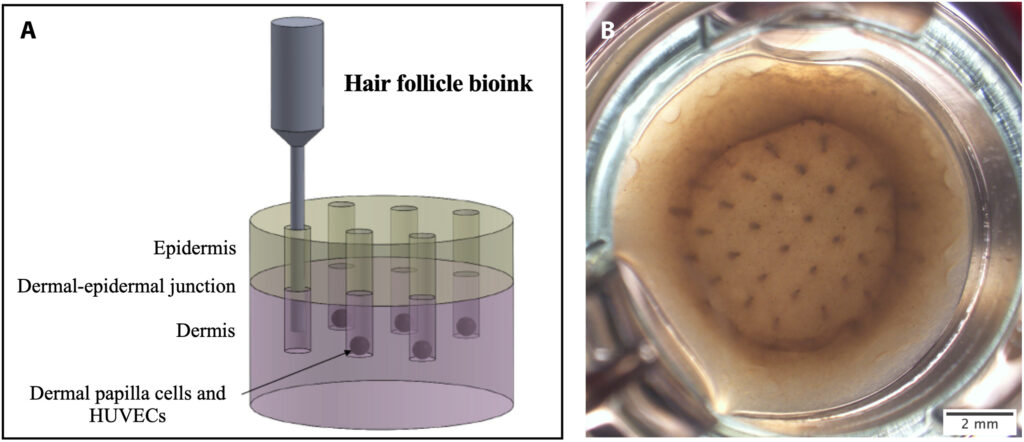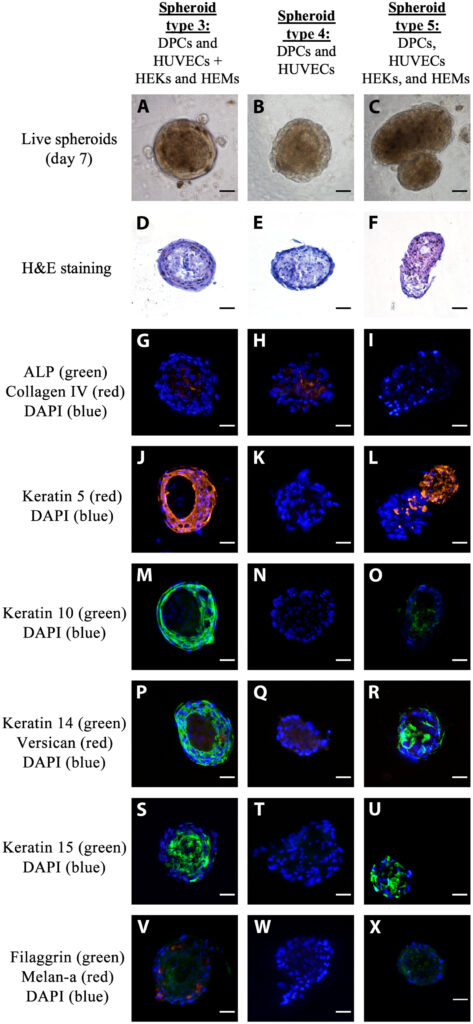CELLINK Bioprinter Enables Bioprinted Hair Follicles for Skin Regeneration and More
In a landmark achievement, researchers at Rensselaer Polytechnic Institute in New York have successfully 3D-printed hair follicles in lab-grown human skin tissue, marking a significant advancement in the field of skin engineering and regenerative medicine. The research, spearheaded by Dr. Pankaj Karande, an associate professor of chemical and biological engineering, was recently published in the journal Science Advances. Key to the experimentation was the use of the Bio X 3D printer from the CELLINK subsidiary of Swedish bioprinting leader BICO.
Advances in Hair Science
The 3D-printing process developed by the researchers involved cultivating skin and follicle cells in the lab until there were enough cells for printing. These cells were then combined with proteins to create a bio-ink that was deposited layer by layer by the printer, creating channels for hair cell deposition. The skin cells migrated to these channels, effectively replicating the natural structure of hair follicles.
The team’s work, which took place at the Shirley Ann Jackson, Ph.D. Center for Biotechnology and Interdisciplinary Studies, revolved around the challenge of reconstructing hair follicles using human-derived cells. Dr. Karande highlighted the importance of their approach in an article for the Institute, stating:
“Our work is a proof-of-concept that hair follicle structures can be created in a highly precise, reproducible way using 3D-bioprinting. This kind of automated process is needed to make future biomanufacturing of skin possible. The reconstruction of hair follicles using human-derived cells has historically been a challenge. Some studies have shown that if these cells are cultured in a three-dimensional environment, they can potentially originate new hair follicles or hair shafts, and our study builds on this work.”
The pilosebaceous unit, which encompasses the hair follicle and the sebaceous gland, is integral to the skin’s overall structure and serves a vital function in the healing of wounds. For that reason, it is a key focus in skin research. The importance of hair follicles, therefore, extend far beyond mere cosmetics, and actually play a crucial role in maintaining skin health.
The Bioprinting Process
According to the study, human dermal papilla cells (DPCs) play a crucial role in hair follicle development, but their ability to drive hair growth diminishes significantly when they are cultured in flat, two-dimensional settings, a stark contrast to their behavior in a more natural, three-dimensional environment. For this reason, the team turned to 3D bioprinting.
 3D bioprinting of hair follicles within skin. Image courtesy of Science Advances.
3D bioprinting of hair follicles within skin. Image courtesy of Science Advances.The research team relied on the BioX 3D bioprinter from CELLINK, controlling extrusion pressure, nozzle diameter, and printing velocity to ensure the survival and health of the bioprinted cells. This included human epidermal keratinocytes (HEKs), human epidermal melanocytes (HEMs), dermal papilla cells (DPCs), and human umbilical vein endothelial cells (HUVECs).
Their initial task involved crafting small-scale models of hair follicles, called spheroids, using a carefully selected combination of skin cells. They either printed these cells or manually placed them onto specialized plates. The objective was to accurately replicate the dimensions of the human dermal papilla, utilizing roughly 3,000 DPCs for each spheroid.
Following this, they embarked on constructing a comprehensive skin model incorporating these hair follicle structures. For this, they developed a unique ‘bioink’ composed of DPCs and HUVECs, occasionally enriched with HEKs and HEMs. This hair follicle bioink was layered onto a foundational bed made from human dermal fibroblasts (HDFs), blended with collagen I sourced from rat tails and dermatan sulfate.
Above this foundational layer, another layer was printed using a different bioink formulated with collagen IV. This layer served as a critical junction between the foundational dermal layer and the uppermost epidermal layer. After an hour of setting, the final step involved adding the topmost layer, the epidermal bioink, which contained HEKs and HEMs, thus completing the intricate skin model that featured integrated hair follicle units.
The skin model was kept submerged for three days and then exposed to an air-liquid interface for 14 days, fostering the proper development and differentiation of the cells. This exposure was critical in skin model development as it promoted the final differentiation of epidermal cells. Currently, the engineered tissues have a lifespan of two to three weeks, which limits the development of hair shafts. The team aims to extend this period to allow hair follicles to mature further, which could have significant implications for drug testing and skin grafts.
 Characterization of complex 3D bioprinted spheroids generated with different cell compositions.
Characterization of complex 3D bioprinted spheroids generated with different cell compositions.Next Steps
According to the “Bioprinting: Markets and Opportunities” report from Additive Manufacturing Research (formerly SmarTech Analysis), the sector could reach $2.8 billion by 2031. Particularly relevant for this research are the subsegments of bioprinting services and materials. While such follicle inks are one potentially lucrative area, bioprinting services are expected to make up the lion’s share of these revenues at $2.06 billion.
BICO Group is uniquely primed to take advantage of this space. Founded in 2016 as CELLINK, the company sells bioprinters, inks, and more. Despite some internal management disputes, BICO’s bioprinters have been widely used in top-tier organizations and universities like Harvard, and by companies like Merck and Novartis. The company now has a new CEO which should propel BICO into a new era of growth.
This latest research from Karande’s team at Rensselaer Polytechnic builds on prior success in printing skin with working blood vessels, marking a significant step in developing better treatments for burns and other skin conditions. The study not only paves the way for hair growth in engineered skin but also sets the stage for transformative advancements in regenerative medicine and dermatological testing. It also opens up possibilities in researching stem cells for regrowing aging hair.
Subscribe to Our Email Newsletter
Stay up-to-date on all the latest news from the 3D printing industry and receive information and offers from third party vendors.
Print Services
You May Also Like
New Business: Temporary, Migratory, & Modular 3D Printed Architecture
If we look at potentially emerging 3D printing businesses, then architecture has not been fully explored. Yes, there is a lot of house 3D printing going on worldwide. From deployable...
3D Printing News Briefs, April 19, 2025: Material Extrusion Standard, Metal Powder, & More
In today’s 3D Printing News Briefs, we’re covering a proposed standard for material extrusion, before moving on to business and metal powder. We’ll end with a commercial store’s robotic 3D...
Japan Unveils World’s First 3D Printed Train Station
Japan is now home to what we believe is the world’s first train station built with 3D printing technology. Located in Arida City, just south of Osaka, the new Hatsushima...
restor3d Raises $38M to Expand 3D Printed Orthopedic Implants
Backed by $38 million in new funding, restor3d is pushing ahead with the launch of four personalized implant lines, set to roll out in 2025 and 2026. This latest venture...

























